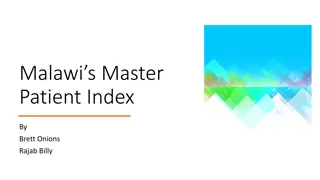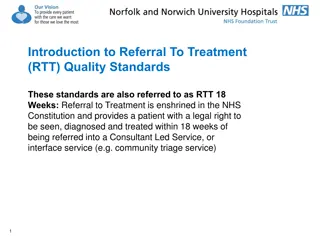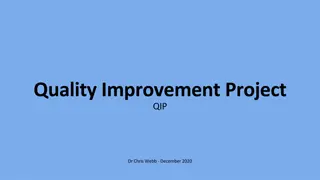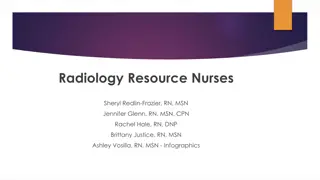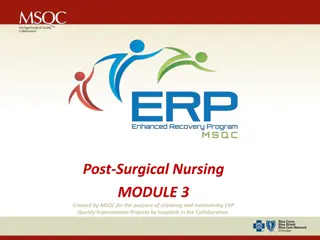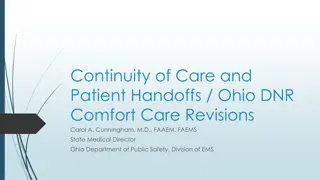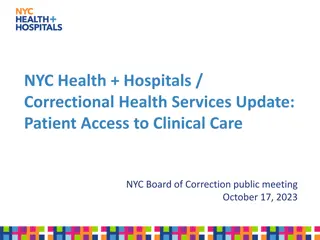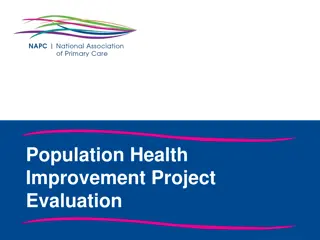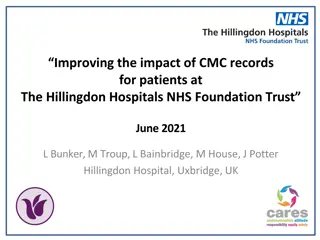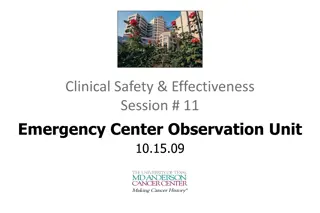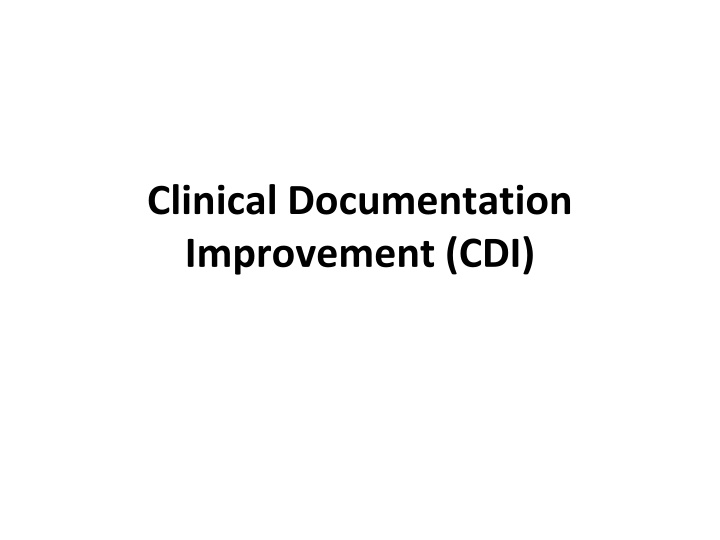
Clinical Documentation Improvement for Accurate Patient Care
Your documentation plays a crucial role in accurately reflecting the patient's condition, ensuring appropriate diagnoses, and improving the quality of care. Clinical Documentation Improvement (CDI) is essential for precise coding, which impacts quality, financial performance, and healthcare initiatives. The CDI specialist acts as a liaison to ensure accurate coding that reflects the complexity of the patient, emphasizing the need for clarity in descriptors, diagnoses, symptom linkages, and continuity of information.
Download Presentation

Please find below an Image/Link to download the presentation.
The content on the website is provided AS IS for your information and personal use only. It may not be sold, licensed, or shared on other websites without obtaining consent from the author. If you encounter any issues during the download, it is possible that the publisher has removed the file from their server.
You are allowed to download the files provided on this website for personal or commercial use, subject to the condition that they are used lawfully. All files are the property of their respective owners.
The content on the website is provided AS IS for your information and personal use only. It may not be sold, licensed, or shared on other websites without obtaining consent from the author.
E N D
Presentation Transcript
Clinical Documentation Improvement (CDI)
Why? Your documentation reflects the patient in the bed, the necessity of clinical diagnostics, the need for continued length of stay (LOS) and the quality of care provided. The final coded record, which is the outcome of your documentation, is shared and available to CMS, data mining agencies and insurers. The information is also used by the hospital to evaluate quality, financial performance and healthcare initiatives for the organization.
Phraseology The Clinical Documentation Specialist is the liaison between provider documentation and the final coded record. The goal of CDI is to make sure the final codes accurately reflect the complexity of the patient. Remember - we are here for you, to discuss an admission or resource our coding experts to make sure we get it right
Descriptors and Diagnoses Why clarify? .. How insufficient is it? Do mild , moderate , severe and profound mean the same to each clinician as a measurable value? Do you know that urosepsis reflects a simple UTI in coding? Is no longer codeable?
Symptom Diagnoses Change in mental status Chest Pain Syncope Weakness Link the suspected or known clinical cause to symptom diagnoses when testing is complete
Continuity Example of lack of continuity: Admission note: Acute renal failure secondary to volume depletion. Progress note: renal insufficiency, dehydration. Discharge summary: patient was admitted with dehydration
Continuity . Example of Continuity: Admission note: Acute renal failure secondary to volume depletion. Progress note: Acute renal failure, improving. Discharge summary: Acute renal failure and dehydration resolved
Diagnostic Terms Clarification of diagnostic terms: Avoid use of up and down arrows for abnormal lab findings. Avoid stating labs noted. Instead, use terms such as hyponatremia, hyperkalemia, anemia (and type of anemia) Approved abbreviations only avoid the use of terms not approved.
Present on Admission POA Present on Admission Every diagnosis is assigned an indicator! In order to determine whether or not a diagnosis was present on admission we may ask for further clarification. Clarification is important to identify if a diagnosis occurred after admission or was POA ie: decubitus ulcers, pneumonia, UTI s etc..
Query Response Please respond to physician queries in one of two ways: If you agree with the question being asked, please indicate in your progress note and if appropriate re-address in the discharge summary. If you disagree with the query, please indicate to us that you ve seen it.
Physician Documentation This module will provide you with key strategies for meeting both professional and hospital documentation requirements because hospital reimbursement and quality metrics are dependent upon physician documentation
History & Physical Chief Complaint Be clear about which complaint (if there are multiple) is the reason for inpatient hospitalization Chronic conditions don t usually require hospitalization unless the condition is exacerbated Document the risk associated with not treating the chief complaint in the inpatient hospital setting Concern for specific complications/adverse outcome The likelihood of an adverse outcome if not treated in the inpatient setting
History & Physical History of Present Illness Includes all the clinically relevant elements related to the chief complaint (why the patient is seeking/ requires inpatient medical care) and includes the information on the following slides:
History of Present Illness Duration How long has the patient had the chief complaint? Be as specific as possible e.g., onset within last 24 hours, onset within last week, exacerbated chronic condition, etc. Severity Is this a typical or chronic presentation or is the chief complaint a new concern? Be sure to note how the patient's condition differs from baseline if this an exacerbation of a chronic condition Be sure to highlight any acute or new symptoms
History of Present Illness Associated Signs & Symptoms Explain the probability of an adverse outcome without immediate treatment or intervention Differentiate new conditions from chronic illnesses; note when outpatient treatment failed and when the condition poses a threat to life or bodily function Clearly specify which are new complaints requiring workup and include the term acute Document your suspected etiology stating evidence of . . . requiring further workup
History of Present Illness Always note an abrupt change in neurological status For existing conditions that are not chronic, state if the condition is resolved or if treatment continues Treated at outside hospital (OSH) for pneumonia; will continue to monitor and treat Treated at OSH for pneumonia; appears resolved
History of Present Illness Chronic conditions Include all relevant co-morbidities/ diagnosis that contribute to the complexity or severity of the case clearly noting A severe exacerbation of a chronic condition Progression of a chronic condition Side effects of treatment for a chronic condition
History of Present Illness Some chronic conditions have associated diagnoses that require more detail: Consider chronic respiratory failure if on home oxygen, CPAP or BIPAP with COPD or obstructive sleep apnea Consider obesity hypoventilation syndrome for the morbidly obese with OSA List all behavioral disturbances for a patient with dementia, noting the type if known Specify the type of heart failure as HFpEF, HFrEF, or systolic and diastolic CHF
History of Present Illness Always note when the patient has failed to follow his/her treatment plan, e.g., missed follow up appointments, non-compliance with medications, etc. The value of this information will increase with the CMS Quality Measure of readmissions as it is important to demonstrate when a readmission was unavoidable due to lack of patient compliance with the treatment plan
Review of Systems (ROS) If you suspect morbid obesity or malnourishment always note it and document how this condition complicates or exacerbates treatment You may want to order nutritional consult which will provide a BMI to support the diagnosis; however, you must document the BMI Include the observations of cachexia/cachectic or emaciated when applicable for general appearance
Past Medical, Family & Social History Address the status of pneumonia/flu vaccines Start asking the status of flu vaccination in September as Quality Measures are based on discharge dates so a patient can be admitted prior to flu season but discharged during flu season If excessive alcohol use requires treatment with vitamins/banana bag, consider documenting evidence of thiamine deficiency and or ETOH use, abuse or dependence.
Past Medical, Family & Social History Consider the diagnosis of narcotic dependence (which isn t the same as abuse) for any patient who has long term use of narcotics or other prescribed substances that lead to a physiological response if abruptly discontinued Note any withdrawal symptoms Specify the type of narcotic This diagnosis should always be considered on any patient requiring evaluation by the pain management team
Daily Progress Notes Documentation of medical decision making should occur daily, so each note should contain Current condition of the patient Remains unstable, remains exacerbated, progression of symptoms, stable with continued concern for . . . Daily documentation must support the continued need for hospitalization Adults who are stable for 12 hours should be transitioning to the next level of care
Daily Progress Notes State all diagnoses being evaluated or managed each day Consider use of a problem list allowing for daily documentation of the status of the condition Note when a suspected diagnosis has been ruled out AND when a diagnosis/complaint has been resolved Link the chief complaint and its etiology to the symptoms that were present on admission (POA) especially when the etiology is not identified until several days within the admission e.g., sepsis, pneumonia
Daily Progress Note Always document the onset of new conditions that occur during hospitalization as acute Be sure to provide documentation and an associated diagnosis for any phone orders Note when you have reviewed and/or discussed diagnostic tests with the performing or interpreting physician Reviewed radiologist findings and agree
Discharge Summary Reiterate the chief complaint and resultant etiology or suspected etiology ( evidence of ) and note when symptoms of this condition were present on admission Patient presented with XYZ secondary to underlying admitting diagnosis of XYZ Patient admitted due to XYZ as evidenced by XYZ presenting symptoms
Discharge Summary List all the diagnoses that were evaluated stating which diagnoses were ruled out and which were treated, including possible or suspected conditions Differentiate new conditions that required workup from chronic conditions that were exacerbated or progressed during the admission Be sure to know when the patient required monitoring for a condition e.g., cerebral edema, as it may appear that treatment was not rendered
Discharge Summary Include any suspected, likely, probable, or possible diagnosis that will require additional care following discharge Always note when the patient requests discharge prematurely Always note the patient s condition upon discharge, verifying the patient was medically stable or palliative care, etc.
Clinical Documentation Improvement (CDI) The CDI staff is composed of nurses , doctors (and coders) that will help you translate the complexity of your patients into diagnoses that can be captured by ICD-10 codes (Call 555-5555) Both quality measures and reimbursement are dependent upon ICD-10 code selection
Chart Queries Whenever there is clinical evidence suggestive of a more definitive principal diagnosis and/or the presences of an incomplete or missing diagnosis, the CDI professional will query the physician for guidance in interpreting the clinical evidence. You can always disagree or state the condition isn t clinically significant or is an incidental finding Coders can t infer or assume, so sometimes CDI staff must ask for documentation that seems obvious and/or ask you to link a symptom to a diagnosis
Chart Queries Include information about your organization s query process Verbal, paper, electronic? Can the medical staff document on the query form? Part of the medical record or not? How does the medical staff respond to a query? Is there a timeframe in which they can respond? What does the provider do if he/she has a question? Is there a query escalation process?
An Example of Elements to Include: Response to a Queries The response time goal for queries is < 24 hours A response should be made to every query whether you agree or disagree If you agree, please update the chart to address the queried issue even if the issue has been resolved Add to the next progress note Example Resolved acute respiratory failure Add to discharge summary Example Experienced acute respiratory failure; resolved with . . . (tx)
Clinical Documentation Integrity If you have any questions about a particular query, or the program in general, please call us. We re happy to help!



